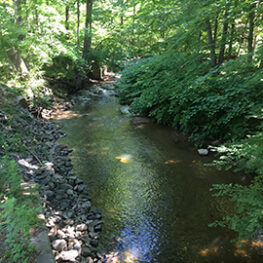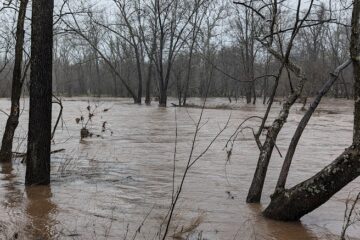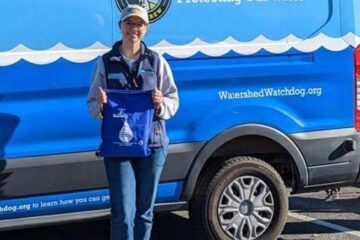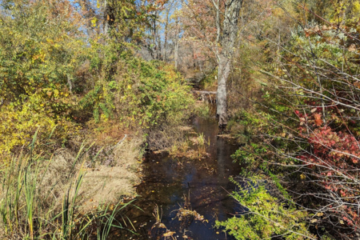 Raritan Headwaters (RHA) fought the renewal of the wastewater permit at Bellemead for 18 years. RHA has worked to protect the Rockaway Creek watershed from degradation and viewed this proposal as a threat to the health of this vital water resource. Water quality degradation and changes to stream hydrology would adversely affect human and environmentally sensitive aquatic and riparian species.
Raritan Headwaters (RHA) fought the renewal of the wastewater permit at Bellemead for 18 years. RHA has worked to protect the Rockaway Creek watershed from degradation and viewed this proposal as a threat to the health of this vital water resource. Water quality degradation and changes to stream hydrology would adversely affect human and environmentally sensitive aquatic and riparian species.
The North Branch of the Rockaway Creek originates in the Highlands Preservation Area of Washington Township (Morris County) and Tewksbury Township (Hunterdon County). It converges with the South Branch of the Rockaway Creek in Readington Township (Hunterdon). The Rockaway Creek drains to the Lamington River and ultimately to the Raritan River, which is a drinking water supplier to over 1.2 million potable water intakes in North-Central New Jersey.
The North Branch of the Rockaway is a NJDEP designated Category 1 stream, defined as waters protected from any measurable changes in water quality because of their exceptional ecological, recreational and water supply significance, or exceptional fisheries resources. The proposed permit for the Route 78 Office Area WWTF would have allowed wastewater discharges to a Category 2 standard. Specifically, limits for pH, DO and fecal coliform were unacceptable and there is no required effluent temperature limit in the permit summary table. Treated wastewater must have a temperature limit placed on it, as in almost all circumstances, the temperature of the waste water discharge will be higher than the ambient water temperature.
Temperature, dissolved oxygen, nutrient levels and sediment loads are issues of great concern in trout waters. Significant mortality in trout populations occur when stream temperatures exceed 70 degrees F. Spawning is triggered by temperature of 54 degrees F. If spawning is interrupted for two or more years, annihilation of the local population is likely. Dissolved oxygen levels decline as temperatures increase creating additional stress factors for trout. Thermal impacts can be particularly serious in the summer and result in DO concentrations that jeopardize the survival of both young and adult trout.
It should be noted that the stream’s classification changes at the 523 County Road Bridge to Category 2 however, because trout don’t recognize politically established boundaries, the discharge upstream would also adversely affect the trout present in the South Branch of the Rockaway.
In 2000, RHA partnered with Tewksbury and Readington Townships to establish the Rockaway Creek Water Quality Monitoring Project. RHA chose sample sites using the U.S. Environmental Protection Agency’s Rapid Bioassessment protocol and on an annual basis submits the project plan to the NJDEP Division of Watershed Protection for review and approval. Over twenty years volunteers and RHA staff have invested valuable time and energy to train and conduct visual and biological stream monitoring along the Rockaway with a mission to protect water quality in the subwatershed.
A major component of the Rockaway Creek Water Quality Monitoring Project involves the collection and analysis of the stream’s benthic macroinvertebrates, recognized as long-term indicators of the ecological status of the stream. Relative to the proposed discharge location are Project Monitoring Sites 7 and 10. Monitoring results of benthic scores over twenty years consistently indicate non-impaired water quality at both sites. RHA believes that the proposed waste water discharge will significantly degrade this stream that has a long history of ecological health.
Finally, RHA was greatly concerned with any proposed development in this vital riparian corridor that contains so many important environmental features. The New Jersey Water Supply Authority (NJWSA), has identified parcels upstream and downstream of the proposed waste water discharge location as critical for water resource protection. NJWSA used GIS technology to identify critical areas for water resource protection focusing on water quality, habitat protection, improved wetland protection and the preservation of trout production and maintenance streams. (attached: Critical Water Resource Area Map, URWA 3-16-11). Property data are analyzed by overlaying the sensitive water resource areas to find out how many sensitive water resource features exist on any given property. Critical Habitats/threatened and endangered species, Riparian Area, Prime Ground Water Recharge and Core/Dense Forest are the criteria components present on the parcels relevant to the proposed development and these parcels have received the highest value as a sensitive water resource.
After DEP initially sought to renew the permit for this proposed development, RHA and others sued. While the case was pending before the Appellate Division, DEP reversed its decision and proposed denting the wastewater discharge permit, effectively ending the ability of this proposed development to move forward. After roughly 18 years of struggle, we can say that the proposed development of Bellemead is dead. Once the denial is final, the bad development proposed for that site will no longer be viable because they can’t develop at the high density they want without the wastewater permit. Tewksbury is already considering more appropriate uses for the property. This is a major win for water quality in Rockaway Creek!
The DEP decision on the permit is not yet final, so it might be a tad early for celebrations.



